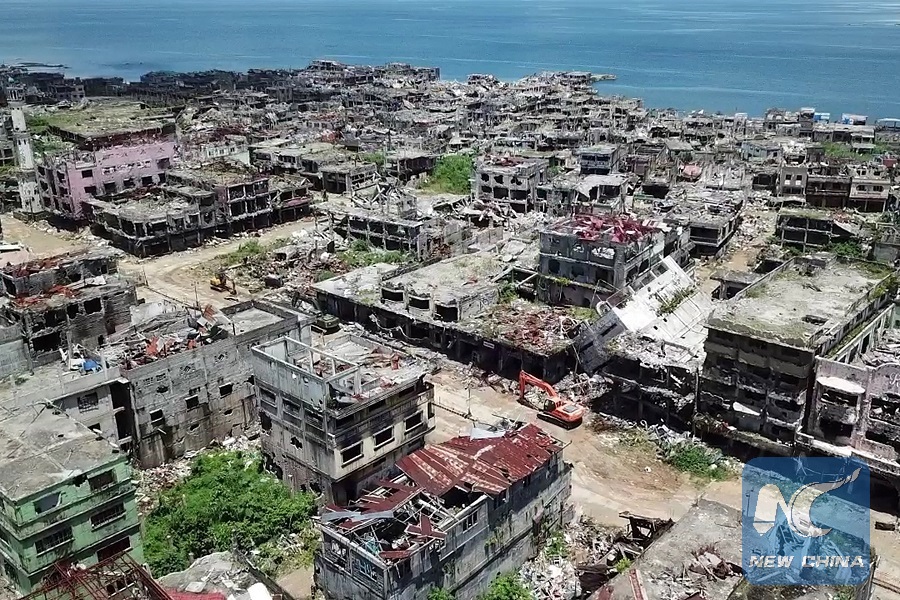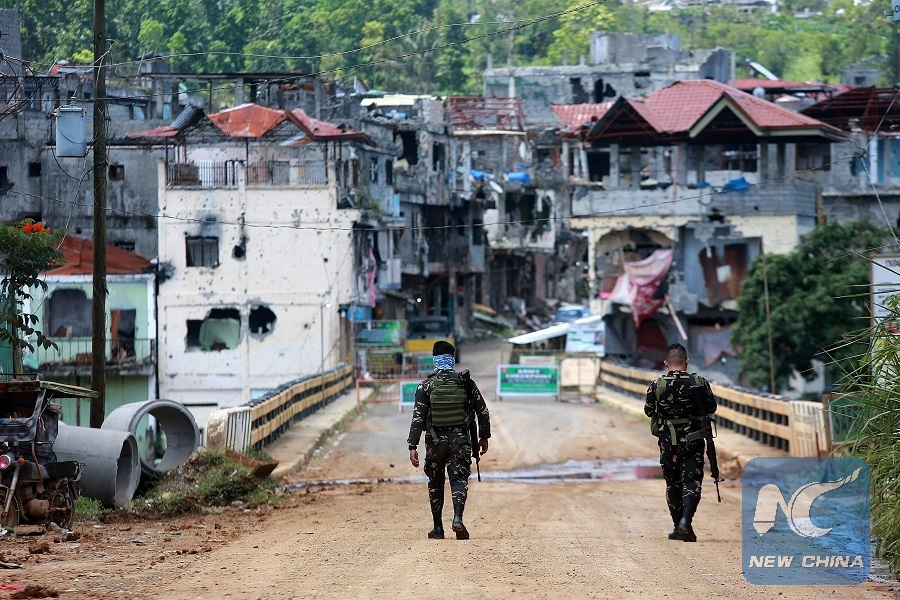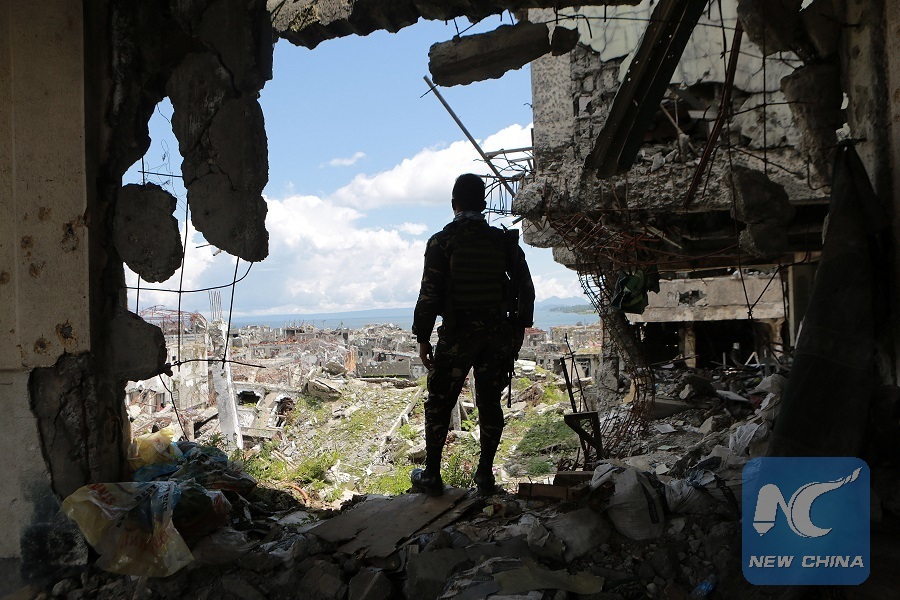
Photo taken on May 22, 2018 shows the damaged buildings in Marawi City, the Philippines. (Xinhua/Wang Yu)
MARAWI, the Philippines, May 23 (Xinhua) -- Norma Abbas, a 60-year-old resident from Philippines' southern city Marawi, has been thrown into anxiety and panic these days. Rumors swirled last week that Islamist militants are planning another attack during the lunar month of Ramadan.
The lady has reason to worry. On May 23 last year, two military tanks and a military truck loaded with heavily-armed troops swooped down on her quiet street in this southern Philippine city.
The government forces were trying to capture Isnilon Hapilon, the pro-islamic State (IS) leader of the Abu Sayyaf militants who plotted the takeover of Marawi along with the Maute brothers, Omarkhayam and Abdullah and they were met by sustained attack from the militants, who fired rocket-propelled grenades, ensuing a ferocious fighting between the government security forces and pro-IS jihadists that attempted to make the city a caliphate in Southeast Asia.
One year later, a "For Rent" sign still hangs on the bullet-riddled building with shattered windows and bomb-inflicted holes in a residential area, which Hapilon and the Mautes rented to plot the Philippines' longest and most intense urban battle in recent history. More than 1,200 people were killed, and hundreds of thousands more displaced.
"(The Marawi siege) was the longest urban battle ever confronted by the Armed Forces of the Philippines (AFP)," said security analyst Rommel Banlaoi in a new study titled "Marawi City Siege and Threats of Narcoterrorism in the Philippines."
Indeed, the AFP took five months to liberate Marawi from the Islamist jihadists that profess loyalty to the IS terrorists based in the Middle East.
"The Marawi City siege was a game-changer in the history of Philippine counter-insurgency operations as the main battle area was an urban terrain and not a guerrilla zone in the forested areas. For almost five decades, the Philippine government has fought armed insurgencies in the countryside. The Marawi City siege taught the Philippine military to learn how to fight in the city," Banlaoi said.

Soldiers from the Armed Forces of the Philippines walk to a bridge in the war-tornMarawi City, the Philippines, May 22, 2018. (Xinhua/Rouelle Umali)
One year after the raid, Army jungle fighter Joseph Quilang said IS militants are again actively recruiting. "They are bitter about their defeat. They want a repeat of the siege," he told Xinhua in an interview while showing reporters around the main battle area.
The main battle area in Marawi is formerly referred to as the Ground Zero after the May 23 attack. The military refers to it now as the "most affected area" or the part of the city where fierce fighting took place between the warring government security forces and pro-IS fighters. The area is now a ghost town of bullet-riddled mosques, buildings, houses and cars, and tons of debris of twisted steel, perforated iron sheets and concrete waste.
Quilang was among the first batch of 205 troops flown into Marawi on June 23 last year. The troops have just completed the Jungle Warfare and Mountain Operations Course (JWMOC) on April 25 that year. Marawi became their first major battle.
"I was totally shocked when I first got here. I was trained to fight in the jungle, not in an urban setting. I remember it was pitched dark when we got into the battle zone. We were literally groping our way," Quilang said.
Out of the 205, he said only 95 survived. Quilang lost his "training buddy," tank gunner Raymundo Gogotano, in the war. His friend was burned alive when the militants set the Simba tank ablaze, Quilang said. Before the burning, he said Gogotano called him to tell that the militants poured crude oil and was about to burn the tank. "I am still mourning for his death," he said.
Quilang toured the Chinese media in the bullet-riddled, bomb-battered Bato Mosque where the last two surviving leaders of Marawi siege Hapilon and Maute made their last stop before in October last year attempting to escape. They were killed before hopping into a waiting boat. Their deaths signaled the end of the devastating war.

A soldier from the Armed Forces of the Philippines looks at destroyed buildings in the war-torn Marawi City, the Philippines, May 22, 2018. (Xinhua/Rouelle Umali)
Quilang said the terrorists are bitter about the war. "They are into recruitment again, offering thousands of pesos to potential recruits. We got wind of it and made some arrests recently," he said.
Army chief Lt. Gen. Rolando Bautista confirmed the presence of IS sleeper cells not only in Marawi but also in many parts of the country.
"We discovered after the Marawi campaign that there are IS sleeper cells not only in Mindanao but also in Luzon and Visayas," Bautista, who previously headed the Joint Task Force Marawi, said in Manila.
"You can see the presence of IS cells in Baguio, Dagupan, Tarlac, Pangasinan (in the Philippine main Luzon Island). In the Visayas (in the central Philippines), there are (cells) in Samar, Cebu and so forth. If they will orchestrate terrorist activities, it might be in the form of lone wolf," Bautista said.
"If they are activated, they can create simultaneous terrorist activities, for example, one or two explosions in one area and an assassination in Cebu, liquidation. That will create a big impact although two or three persons will carry that out. That is their most probable strategy in the meantime," Bautista warned.
However, Bautista expressed doubt that militants can launch a Malawi-like siege in the next three to five years. He said the strength of the militants has been significantly reduced after their defeat in Marawi.
In the military's assessment, he said "the (enemy) threat is totally reduced in terms of leadership, in terms of armament, in terms of foreign support" adding that the "hardcore (IS) fighters have been neutralized."
Bautista nevertheless said that IS-influenced groups "are still recruiting," although the Maute group had been "reduced in terms of strength and capability."
Bautista tagged the Abu Sayyaf, the Bangsamoro Islamic Freedom Fighters and the Khilafah Islamiyah Mindanao as among the IS-influenced groups.
He said the attack in Marawi was carried out by an alliance of the different terrorist groups. "If they were able to do that in Marawi, then chances are they can do it again. But our assessment is that it will take more or less three to five years before they can repeat what they did in Marawi," Bautista said.
Housing Assistant Secretary Felix Castro, Task Force Bangon (Rise) Marawi field office manager, echoed Bautista's assessment. "We continue to be vigilant. We do not want these people to disrupt the rehabilitation process," he said.
"A small incident would scare away investors or developers, and the development will not push through. So, we are very vigilant and we continue to coordinate with the military and the military continues to address these concerns," Castro added.
Asked if he considers the IS regrouping as a threat, Castro said, "We don't think so. At this point in time from what I learned those who are recruiting are small in numbers and the recruits are actually young and untrained so it will take time for them to really gather enough strength, enough firearms, enough experience or training to stage another siege."

